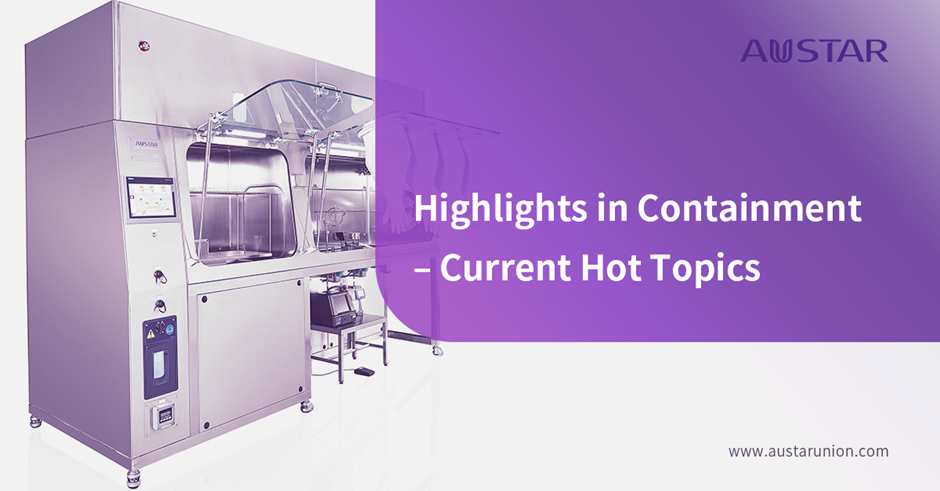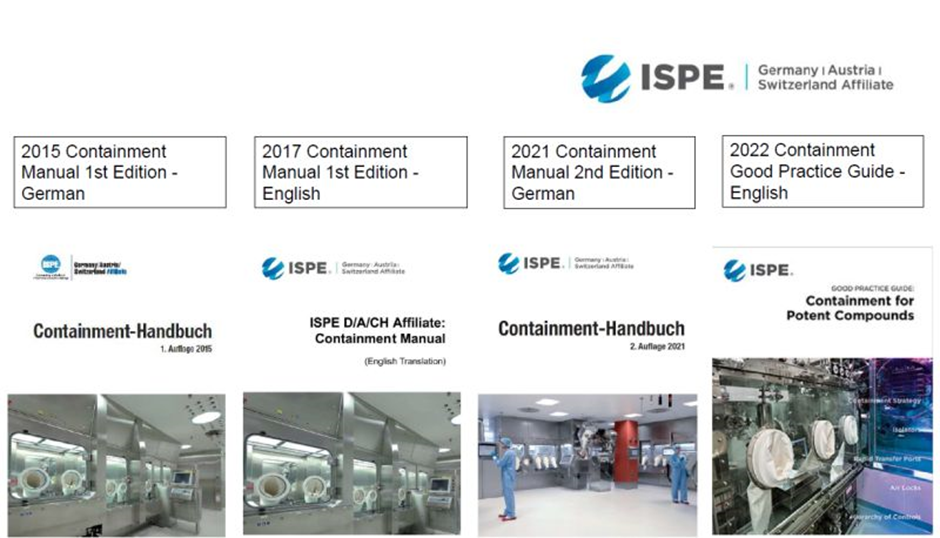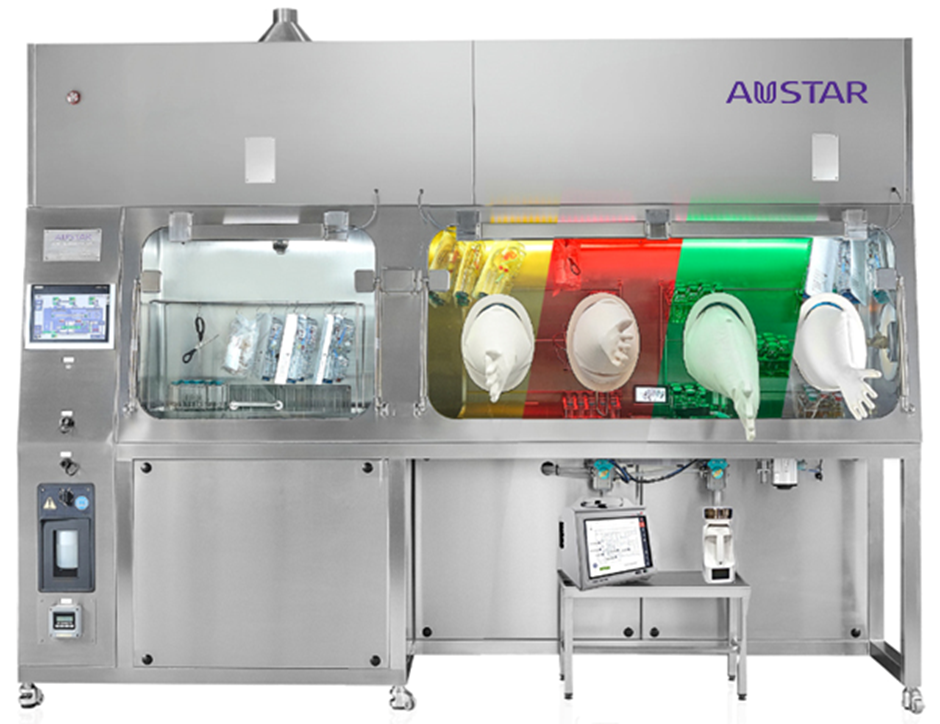Highlights in Containment – Current Hot Topics
News & Insights2023-03-09
Introduction: Increasing importance of containment
General interest in containment has increased significantly in recent years. Various factors may have contributed to this phenomenon. One of them is the fact that many of the new therapeutic molecules target their receptors very precisely. Being targeted generally means that small doses are sufficient to trigger the wanted effect, in other words, these molecules are potent and need contained production equipment. Smaller doses also mean smaller production volumes. For some products, less than 100 kg/year cover the whole global market. Such small-scale products are generally made in shared facilities where good primary containment is particularly important as an effective means of controlling cross-contamination. Finally, globalisation and outsourcing of manufacturing activities to foreign countries has led to the global spread of high EHS standards. Especially large pharma companies are subject to continuous monitoring of their sustainability by investors. They do not want to get caught working with CDMOs that have poor EHS standards. Therefore, they avoid doing business with CDMOs where the protection of workers from overexposure depends heavily on personal protective equipment which has been shown to be much less reliable than engineering controls (= contained equipment).
This article highlights a few aspects of containment that are the focus of recently increased attention. Therefore, this article is by no means to be considered a comprehensive overview over this complex topic.

Gaining knowledge on containment
The increasing interest in containment has led to a demand for reliable sources of information on the topic. Many expensive seminars and webinars are offered with fancy titles such as “global highly active pharmaceutical ingredient summits (HAPI summit)” but their content is often more modest than the income they generate for their organisers. Some consultancies offer good training, but it is expensive and may not be easily accessible for other reasons.
Until recently, there have been no textbooks on containment that would have been worth recommending. In 2015, the Swiss, German and Austrian regional containment community of practice of ISPE published a rather comprehensive containment handbook which was translated into English in 2017. A second German edition was issued in 2021. It served as the basis of a “global” ISPE good practice guide on containment which became available in 2022. Unfortunately, at the last minute, ISPE headquarters changed its name from “Containment” to “Containment for Potent Compounds”. This new title is misleading as the publication is not a guide on containment for potent compounds. One of its main messages is that containment is necessary for handling any and all pharmaceuticals. The levels of containment and the containment solutions will obvious differ depending on potency, volume, physical characteristics and other parameters related to the material handled.

Brief, with this ISPE Good Practice Guide, there is finally a textbook of reasonable quality available to the general public.
Containment for worker protection, containment for GMP
Starting in the US and in Europe in the 1970s, the science of occupational hygiene has promoted the fact that compared to personal protective equipment, engineering controls, essentially synonymous with “containment systems”, were more reliable and effective to protect workers from overexposure to workplace hazards. It eventually became the law in Europe and in the Americas to protect workers primarily by hazard containment at the source. International conventions such as one of the ILO confirmed this principle as good occupational hygiene practice.
The classical routes of cross-contamination during the manufacture of drugs are mix-up of materials, insufficient cleaning of product contact surfaces and cross-contamination by airborne or mechanical transfer. For airborne cross-contamination and mechanical transfer to occur, material has to escape from the production equipment to contaminate the air and the non-product contact surfaces (floors, walls, outside of the equipment etc) in the production facility. Process containment is designed to minimise such escapes of product. In 2014, the revised EMA GMP guidelines acknowledge this. In their ch. 5.21, they list possible measures to demonstrate that a facility has its cross-contamination risk under control, for ex.: “…verification of cleaning of non product contact surfaces and monitoring of air within the manufacturing area and/or adjoining areas in order to demonstrate effectiveness of control measures against airborne contamination or contamination by mechanical transfer.”
Consequently, both manufacturers and GMP inspectors have been paying more attention to process containment as it is the only means of reducing contamination of the immediate production environment. No guidance exists for the interpretation of sampling results of air and non-product contact surfaces in the production room. One reason for this may be that the relationship between such contamination and any product risk is very indirect and hard if not impossible to quantify.
Limit values for worker protection, limit values for GMP
Occupational exposure limits (OELs) for APIs have been established in the pharmaceutical industry for probably 50 years. To set such limits, any available information on the drug, including mode of action, therapeutic dose and preclinical data, was evaluated. These limits were a first generation of health-based exposure limits (HBELs).
With its new GMP guidelines issued in 2014, the EMA established an obligation for companies to base their cleaning limits for product-contact surfaces in shared facilities on analogous HBELs. These HBELs replaced earlier bases for cleaning limits such as the 0.1% therapeutic dose limit, the 10 ppm limit as well as the assessment of a compound’s criticality based on the drug family it belonged to: cytotoxics, hormones, potent drugs, antibiotics etc”.
Later in 2014, the EMA provided guidance for the expert on how to set these HBELs, also referred to as PDEs (Permitted Daily Exposures). The pertinent EMA GMP guidelines along with the EMA’s guidance on setting HBELs were later adopted verbatim by PIC/S. With this, they have become an important global GMP reference.
It is well-established practice today to develop OELs and PDEs by the same work process. Differences between these limits are that PDEs are expressed as dose per day (µg/day), OELs as air limits (µg/m3). When establishing these limits, differences of bioavailability for the relevant routes of exposure must be taken into consideration. For OELs, the exposure route is always inhalation, for PDEs, it is the route of administration of the drug that carries the contaminant.
Developing PDEs and OELs in the same process ensures that the two are well harmonised and any differences are clearly explained. Using other guidance for setting OELs may lead to OELs that diverge from the PDEs. The main reason is that such other guidance was written for chemicals in general where the available dataset is often very different from the dataset available for pharmaceuticals. In particular, clinical data which are the main pillar for setting OELs for pharmaceuticals are normally totally missing for commodity chemicals.
Primary and secondary containment
Total containment is the combined effect of primary and secondary containment. Primary containment (often referred to simply as “containment”) is what keeps the material inside the production equipment, secondary containment is there to prevent the further spread of material that has escaped from the production equipment despite the primary containment.
Logically, if material escaping from the equipment is a serious concern, the action should be to correct the primary containment and not an effort to build a fortress around the production room to keep escaped material inside.
Historically, the opposite has often been done. In GMP inspections, there is typically still little attention paid to primary containment and all the discussion circles around secondary containment. Airlocks, pressure differentials, air recirculation yes or no, air exchange rates, clothing changes are all measures of secondary containment that would become much less relevant if primary containment was strengthened. Obviously, the frequency and consequences of incidents, i.e. failures of the primary containment, also play a role in the design of secondary containment. With the enhanced focus that GMP is now placing on primary containment, accepting reductions of secondary containment will be the logical consequence. Secondary containment is expensive to build and very expensive to operate and maintain. It does not address the root cause of the problem which is material escaping from the equipment. And there is very little if any benefit for the worker from secondary containment.


Containment: additional expense or money saver?
Investments in primary containment are often high. Enhanced primary containment may also lead to a reduction of productivity (e.g. slower work pace when using an isolator). Yet, many companies have performed cost-benefit analyses that have shown positive surprises, i.e. they have shown a very good pay-back of the investments in primary containment. Every situation deserves its own assessment which quantitatively considers the following potential benefits of improved primary containment, for example:
1.Elimination or reduction of personal protective equipment (PPE), over-gowning and other consumables
2.Increases in quality and product conformity, less exposure of the product to the manufacturing environment and worker
3.Decreased potential for cross-contamination
4.Reduction of product loss (particularly relevant for new expensive products) – what is in the air or on the floor cannot be sold as finished product
5.Decreased potential for a deflagration caused by aerosolized explosible powders or flammable vapor concentrations
6.Decreased room air changes (energy savings)
7.Increased air recirculation (energy savings)
8.Simplified airlock systems (reduced construction cost, reduced monitoring of pressure differentials, energy savings)
9.Decreased potential for loss of API to the environment (an important issue with antimicrobial resistance in case of antibiotic emissions)
10.Increases in productivity due to shortened or eliminated change-over times, faster transfer of product between unit operations (e.g. via vacuum transfer), decreased time spent gowning and de-gowning and scrubbing in…
Containment for the most frequent operation in pharma manufacturing
What is the most frequent operation in pharma manufacturing? Weighing and dispensing? Sampling? No, it is transferring material from one operation to the next.
Often, these transfer operations are ill-contained and lead to significant exposures – or they are complicated. Discharges of an equipment into a drum leads to high exposures, and high exposures occur again if the material then needs to be manually transferred from the drum to the next piece of process equipment. Using an endless liner to discharge a product may be a very well contained process, but it practically forces the recipient of this crimped endless liner “sausage” to use an isolator if he wants a contained transfer of the material into the next piece of equipment.
Systems have been developed and more systems are needed that allow the contained discharge of material from one piece of equipment into a container that can then be directly docked to the next piece of equipment in a contained way. Such solutions need to be so standardised that in the end, everyone can use them.
Examples of existing systems are flexible transfer bags with connections that can be used for charging and discharging, drums with alpha-beta ports, disposable split butterfly valves or high-containment bulk bags (also called big-bags or flexible intermediate bulk containers, FIBCs). The latter may still lead to exposure peaks of several µg/m3 when disconnected, but a large amount of material can be transferred with one single connection/disconnection. Therefore, the total exposure dose per transfer of a given amount of material can be very low.
Containment measurement and monitoring
Before installing any containment technology, a conscious decision is needed as to what products will be made with the equipment in question. Potency, volumes and physical characteristics of the products that will be produced will be key factors in deciding on the containment solution needed. This decision must be reflected in a user requirement specification (URS) for containment. This user specification must always be expressed as a clear limit (e.g. “1 µg/m3”), never as a range (e.g. “OEB 4”). With this containment URS in hand, the company can go to the equipment market and look for a containment solution that meets this URS. Anyone offering pharma manufacturing equipment should be able to provide information on the containment capability of the equipment that is for sale. ISPE has issued a good practice guide on how to measure such containment performance in a standardised way. It is generally referred to as “SMEPAC”. SMEPAC testing is rather cumbersome and expensive. Therefore, it is often only done by the equipment manufacturer when he develops a new type of equipment and again for every piece of containment equipment once it has been installed in the facility where it will be used (so called Site Acceptance Test, SAT). Later SMEPAC tests are not popular because of the cost and the organisational effort. For these reasons, alternatives to test the containment capability of equipment are being developed and have recently been presented. They avoid the big effort of SMEPAC-style sample collection and chemical analysis. These alternatives may become popular especially for periodic testing of equipment, once it is in use. Here are a few examples of such devices:
GEA/Buck® has developed the “Digital Canary®”, a sensor that can be integrated into some of their equipment (e.g. split butterfly valves, tablet compression systems) and which quantitatively and continuously monitors dust emissions at the critical locations. It measures the correct fractions of the particle size spectrum (inhalable dust according to ISO 7708) and delivers the results in µg/m3. The accuracy of the results for different substances is predictable without calibration.
Nanozen® offers a portable instrument that continuously measures dust concentrations (in µg/m3) by means of an optical sensor. It does so in the breathing zone of the worker. It can be calibrated for specific APIs.
Stat Peel® has developed portable badges that collect dust from the worker’s breathing zone onto a filter. The badge is inserted into a Raman spectroscopy analyser at the end of the shift. This analyser delivers the result (µg/m3) within minutes. It must be calibrated for the analysis of each molecule.
Particle counters can be used to detect emission sources, but they cannot be used to quantify the toxicological relevance of these emissions. To assess worker exposure, it is not the number of particles (“particle count”) that is relevant but the suspended mass of inhalable particles in µg/m3 (ISO 7708). The following scenario illustrates this: In this scenario, there are two types of dust, both with the same number of airborne particles. Dust cloud A has particles of 0.1 µm of diameter, cloud B has particles of 10 µm of diameter. The particle counter will deliver the same result for both dusts as the number of particles per m3 is the same. However, to assess worker exposure, the suspended mass in µg/m3 is relevant. The spectrometer that measures mass will deliver a result 1 million (!) times higher for dust B compared to dust A.
There are various aspects of containment where there have been recent and current developments and which have therefore attracted increased interest and attention. This article is an attempt to show this in a kaleidoscope style.
Written by
Dr. Andreas Flückiger AUSTAR Consultant







 Search
Search 中文
中文









